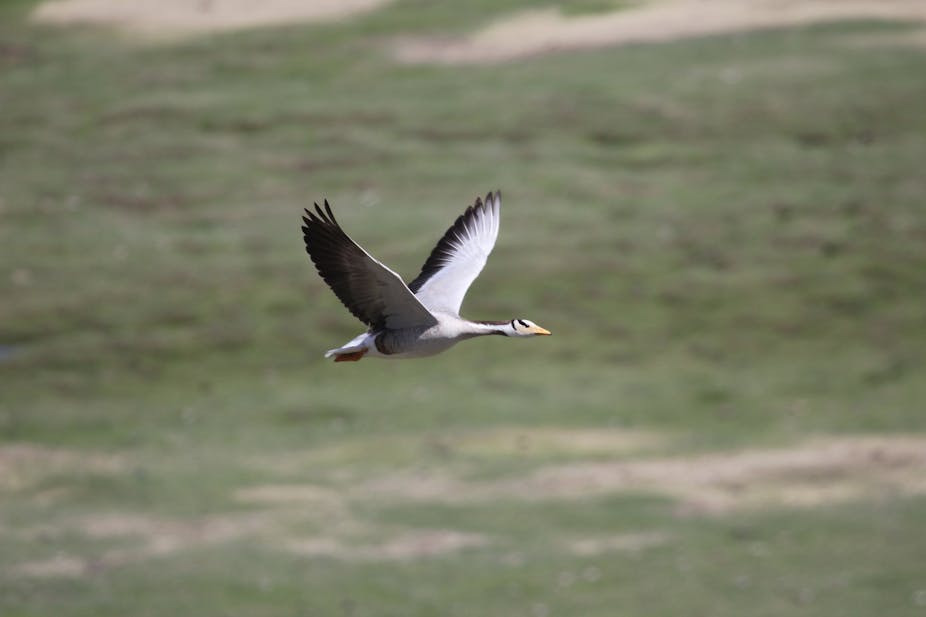There aren’t many animals high up in the Himalayas, but the odd bird passes by. Each year bar-headed geese (Anser indicus) travel from their breeding grounds in China and Mongolia to spend winter in the Indian subcontinent. It’s a journey that takes them through some of the tallest mountains in the world and there are even old reports of these geese flying over Annapurna and even once over Mount Everest.
We knew these birds were well adapted to flying at lofty altitudes but until now we assumed they hit some chosen top altitude and flipped on cruise control. However, new research published in the journal Science by myself and an international team of scientists found otherwise. After tracking the geese we discovered they actually stick close to the mountains, following the peaks and valleys like a rollercoaster.
It’s an unexpected approach to a tricky problem. At higher altitudes, air gradually becomes less dense and the atmospheric pressure drops. This means birds must flap their wings ever faster, deeper or both in order to generate the lift and thrust required to keep them flying fast through the air.
At the same time, the availability of the oxygen required to sustain these flights is reduced. At 5500m – just above Everest Base Camp – a lung full of air will contain around half the oxygen obtained at sea level.
Going for a ride
Herons, egrets and other birds that fly high above the ground, but not necessarily over mountains, often climb steadily and then level off at a specific altitude (typically between 2,000 and 7000m) when they find suitable tailwinds which help propel them along at high speeds.
Bar-headed geese could follow a similar strategy. After all, their lungs are 25% larger than other geese and their cardiac and flight muscles contain more blood vessels – all ideal adaptations for a low-oxygen environment. Their blood even contains slightly modified haemoglobin that gives it a higher affinity for oxygen than many other birds.

However, when we tracked these geese we found they seldom maintained a constant altitude at all. They might descend many hundreds of meters only to have to climb again later in the same flight. The birds mostly stayed within 100m or so of the undulating terrain and only flew as high as was necessary.
Due to the many ups and downs recorded on longer flights, we termed this the “rollercoaster” strategy.
Follow that goose
To understand how and why bar-headed geese made these flights we developed a customised data logger which we implanted into their abdomens (after catching them in Mongolia) where it stayed all year. We put a coloured ring around their necks so that we could identify them the following year.

The logger would record flight altitudes, body temperature, heart rate and body motions (used to determine wingbeat frequency and overall accelerations). Both heart rate and wingbeats went up with increasing altitude and decreasing air density, indicating that at high altitudes even horizontal flight was hard work.
Using this data we calculated that, without a helpful tailwind, staying at high altitude would not be worth the extra flapping. For the geese the most efficient route is to track the underlying terrain and stay in reasonably dense air. This helps to reduce the energy used up flying while at the same time making more oxygen available.
Extra flapping uses a great deal of energy. Even just a 5% increase in flap frequency results in an average 19% increase in heart rate and a 40% increase in oxygen consumption. This is because, unusually, bar-headed geese increase the size of their flaps along with their frequency.
Given we know what the air pressure at any given altitude is likely to be, we can calculate the flaps necessary for the goose to stay airborne. However the increasingly extreme extra effort involved in eking out those extra flaps means even this species will eventually hit its ceiling. Our calculations say “peak goose” could be somewhere nearer 8,000m than 9,000m (perhaps depending on the weather), they simply don’t have the heart or the lungs to keep flapping beyond this point.
So the Mount Everest (8848m) sightings might just about be plausible, perhaps with assistance from updrafts deflected from the valleys, but seem unlikely. I would love to hear from anyone with some good evidence of geese at these altitudes. I would certainly not expect them to stay there for very long!
What is clear is that these birds have evolved to keep their flight costs to a minimum by regularly returning to lower altitudes whenever possible and only flying as high as the terrain dictates. Bar-headed geese are exceptionally well adapted to flying at high altitude when necessary, but they chose to make it the exception rather than the rule.

